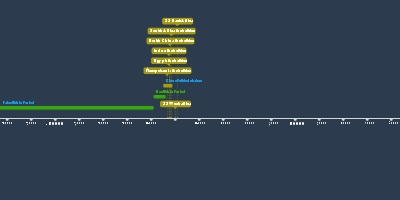Rise of cities/states (1 janv. 5000 av. J.-C. – 1 janv. 1200 av. J.-C.)
Description:
Mesopotamia and Egypt- Main topics
- How growth of cities affected the lives of people
- Social hierarchies
- Architecture/tech innovations
- Religon
- Writing
- Compare Egypt to Mesopotamia
- First larger states in ME and EM areas
- Civilization
- Def:
- A society with a high degree of cultural and technological development, with urban centers
- “Uncivilized” as being a negative sense
- Barbaric/unsophisticated
- From Romans who saw them as less and conquerable
- Civitas - Latin for cities
- ON QUIZ (is “civilized” as an adjective ok? Or too negatively loaded)
- “Mesopotamia” - land between the rivers
- Had well established agriculture
- Fertile Crescent - The land between Tigris & Euphrates rivers
- Rivers
- Provide large scale food production
- Irrigation connected to rivers
- Rich ecosystem
- Trade and transportation
- Sumerians - First inhabitants of S Mesopotamia
- First city builders
- Uruk - believed to be the earliest one
- City states
- Each city is its own state, independently ruled
- Economic center
- Important meeting place in commerce
- Manufacturing
- Specialized labor
- As cities grew, so did trade
- Sumerian cylinder seal
- Like a stamp, affixed contracts/ownership
- Distant areas also developed
- Religious center
- Polytheistic
- Multiple gods etc.
- Different gods has different purposes & domains
- Religious personnel often provided gifts to gods for divine protection and fortune (reciprocal relationship)
- Largest religious structure in middle of city
- Ziggurat - Mesopotamian temples
- Largest building in the city
- Distance from Ziggurat indicated importance
- Far - less important
- Center of political power
- Developed power hierarchies in cities
- Kings
- Functioned as high priest & military commander
- Generations (dynasty)
- Birthright nobility & royalty
- Priests were also quite powerful
- Development of patriarchal systems
- Men rules
- Family & state were seen as similar entities
- Some exemption
- No male
- Not all men were more powerful then all women
- Men ruled men and women
- Class was more important than gender
- Functions that hold today
- Writing systems
- First in Mesopotamia
- Egypt only slightly behind
- Taxes
- Contracts
- Marriage
- Business
- Regulation/law
- Religion
- How?
- Step 1: Began with pictography
- Step 2: Ideograms/conventional signs
- Scribes
- Cuneiform in mesopotamia
- 3200 BCE
- Phonetic
- Wedge shaped tool on clay
- Step 3: Alphabets, logographic systems (not in anc. Meso.)
- Western Syria 1800 BCE
- Phonetic
- Roman alphabet
- What we use today
- Epic of Gilgamesh (c 2100 BCE - 1500 BCE)
- Cuneiform
- Story of a legendary king
- Egypt
- Developed around the Nile
- God like king Pharaoh
- Starting 3000 BCE
- Polytheistic
- Cities not central for political rule, but still for religious ceremonies/markets etc.
- Pyramids
- Built 2500’s - 2400s
- 4000 years ago
- Ordered by pharaohs
- Tombs
- Very luxurious
- For the purpose of afterlife
- Proof of wealth
- Developed mummification so that the dead person could use the body in the afterlife
- Ex. Ramesses I (d. 1290 BCE)
- Most could not afford
- Exposed to arid desert
- Systems of slavery
- Hieroglyphs
- c. 3000 BCE - c. 400 CE
- Pictographic
- Development of large territory states
- 1600 BCE 1200 BCE
- Centralized political power
- Mess. City state 3000 - 1600’s BCE
- Hittite state in Turkey
- Babylonia
- King Hammurabi
- Began conquest
- 1700’s BCE
- How do you control cities you’re not in?
- Instituted law over land
- Controlled in abstract power
- Can learn morals etc.
- Hammurabi’s law (Stela)
- Cuneiform
- Placed in many controlled cities
- Shamash (god of truth and justice)
- Shamash and Hammurabi placed together on Stela to prove authority
- 196: Eye for an eye - with a member of aristocracy
- 198: Pay reparation - with a normal citizen
- 199: Pay reparation but half - with a slave
- Connection between the states
- Trade, diplomacy, military etc.
- Innovations spread through trade
- Iron smelting in 1500’s
- Assyrian & Persians challenged Egypt and Mesopotamia
Ajouté au bande de temps:
Date:
1 janv. 5000 av. J.-C.
1 janv. 1200 av. J.-C.
~ 3802 years
